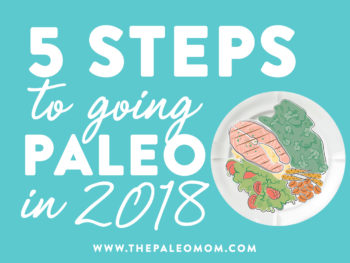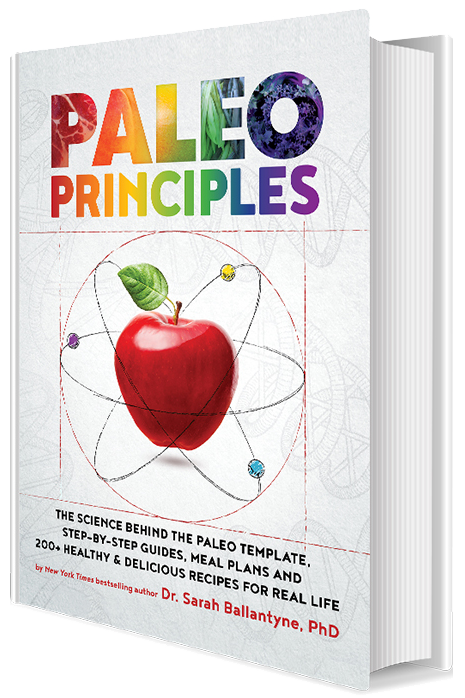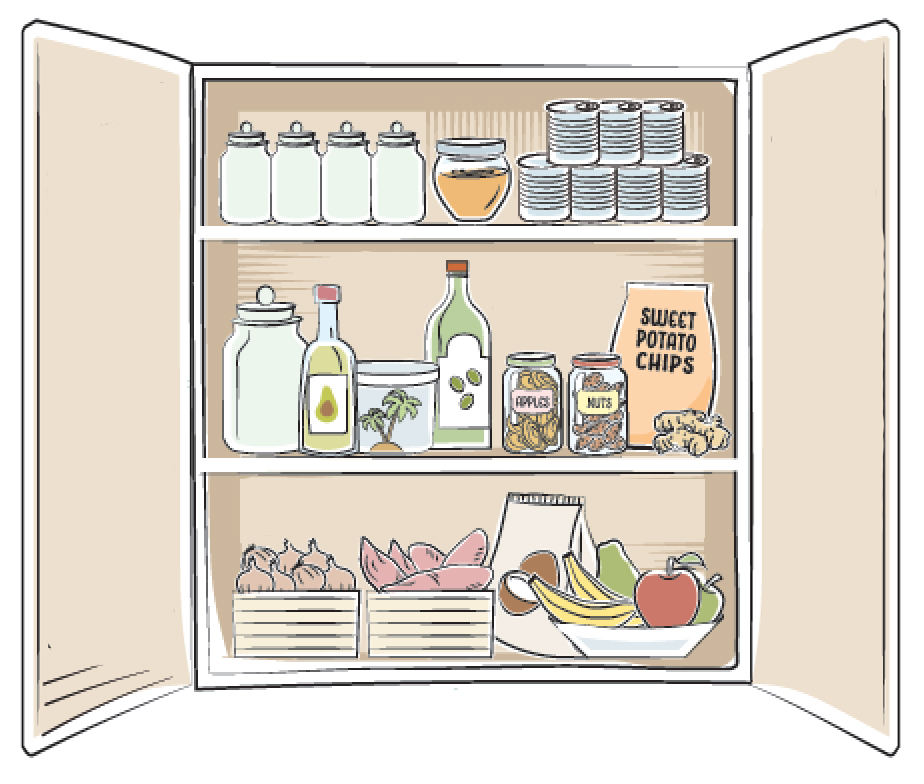Is “going Paleo” your New Years Resolution?
I’m excited for you! It’s been over 6 years since I made the leap into Paleo and I have never looked back. Over the years, I’ve fielded so many questions from others interested in going Paleo and it’s a decision I always encourage (I am The Paleo Mom, after all!).
What IS Paleo? In short, Paleo is a nutrient-focused whole-foods diet, with the goal to maximize foods that heal and minimize foods that harm. It improves health by providing balanced and complete nutrition while avoiding most processed and refined foods and empty calories. It’s not a way to simply lose pounds quickly (even though, for many people, it has that effect!), and it’s not a fad that dissolves under scientific scrutiny; rather, every Paleo principle is rooted solidly in the latest research and data (see “What Is Paleo?” and Paleo Principles).
But, I do advocate moving forward with dietary changes in a smart, calculated manner. In my post “Transitions: All In or Baby Steps,” I explained that successfully transitioning to a new dietary protocol is a matter of balancing compliance and sustainability. In this case, compliance means how closely you adhere to the Paleo diet, and sustainability means how well you are able to maintain the changes you’ve made. Achieving a balance of these two factors is the sweet spot for making your resolution stick!
Pausing to reflect on the steps highlighted in this post might be just the shift you need to make 2018 the year you successfully “go Paleo” for good!
1. Focus on “Why” You’re Going Paleo
 Understanding why going Paleo is important to you is a first, crucial step in your plan for success. That’s because a why—one that includes both personal motivations and an understanding of the science behind the Paleo diet—will keep you moving forward when things get tough.
Understanding why going Paleo is important to you is a first, crucial step in your plan for success. That’s because a why—one that includes both personal motivations and an understanding of the science behind the Paleo diet—will keep you moving forward when things get tough.
Let’s start with your personal motivations. Whether you’re looking to lose weight, manage diabetes, reduce risks of cancer and cardiovascular disease, mitigate autoimmune disease, improve your performance or simply want to experience the best health possible, the Paleo diet is your best bet.
Perhaps you want more energy to play with your kids, to minimize your risk of chronic disease, or to avoid a medical condition that affected your family members. Great idea! Or, perhaps you just want to improve athletic performance, minimize bloating, or clear up your skin. Perfect “why’s.” I suggest writing down your “why/s” on a sticky note and affixing it to your fridge, bathroom mirror or calendar—anywhere you know you’ll see this daily reminder when you’re tempted to go “off plan.”
Now, let’s discuss the scientific “why’s.” Perhaps it’s just the way my science-focused brain works, but I’m always skeptical of “big changes” unless I’ve seen the scientific research to back them up.
As Paleo has grown from a relatively underground movement to a diet that dominates news headlines, covers bestselling books, and even produces products in the grocery store, it’s gained plenty of followers. But despite its popularity, the scientific rationale for Paleo remains wildly misunderstood and misrepresented. Though we might know that grains are a no-go, that vegetables are fantastic, and that dietary fat is nothing to be afraid of (despite years of the low-fat push from various health authorities), many people still believe these guidelines are designed to re-enact the behavior of our ancestors. This isn’t why I follow the Paleo diet at all! In fact, I follow it because it’s a scientifically-grounded approach to eating and a “diet” in which every choice and behavior is backed by solid evidence.
 Where can you go to understand why the Paleo diet looks like it does? My number 1 recommendation is to pick up a copy of my book, Paleo Principles. I know, I know—but it really is the most comprehensive resource out there, and the only one that will explain WHY you’d want to make this sort of dietary and lifestyle change with comprehensive scientific research, plus plenty of HOW including recipes and meal plans.
Where can you go to understand why the Paleo diet looks like it does? My number 1 recommendation is to pick up a copy of my book, Paleo Principles. I know, I know—but it really is the most comprehensive resource out there, and the only one that will explain WHY you’d want to make this sort of dietary and lifestyle change with comprehensive scientific research, plus plenty of HOW including recipes and meal plans.
Nutrivore Weekly Serving Matrix
An easy-to-use and flexible weekly checklist
to help you maximize nutrient-density.
The Weekly Serving Matrix is very helpful! I’ve been eating along these lines but this really helps me know where to focus vs. which foods serve a more secondary role. It’s super helpful and has taken a lot of worry out of my meal planning. Thanks!
Jan
The Start Here section of my site is also packed with helpful info, including an explanation of every food that’s included and eliminated on Paleo, and the post “Paleo Diet Clinical Trials and Studies” is updated regularly. Plus, I post new, science-based posts on my site, ThePaleoMom.com, every week.
2. Understand How
 There are plenty of definitions of Paleo bouncing around the internet, and not all of them recommend the nutrient-dense, nourishing approach that’s worth pursuing if you’re going Paleo in 2018. The best way to set yourself up for success is to ascribe to a definition of Paleo that will actually improve your health!
There are plenty of definitions of Paleo bouncing around the internet, and not all of them recommend the nutrient-dense, nourishing approach that’s worth pursuing if you’re going Paleo in 2018. The best way to set yourself up for success is to ascribe to a definition of Paleo that will actually improve your health!
Beware of blogs, books, and personalities who recommend an extreme approach to dietary transition. In some cases (like those where you’re treating an autoimmune disease or neurological condition, or working under a doctor’s supervision) a 30-day elimination period might be warranted.
But for most of us, a gradual approach is best. Here’s how I define the Paleo diet: it’s a nutrient-dense whole foods diet based on eating a variety of quality meat, seafood, eggs, tons of vegetables, fruits, nuts, seeds, herbs, spices and healthy fats. It improves health by providing balanced and complete nutrition while avoiding most processed and refined foods and empty calories.
 Following a Paleo diet is actually pretty simple. There’s a huge variety of health-promoting foods to choose from, including
Following a Paleo diet is actually pretty simple. There’s a huge variety of health-promoting foods to choose from, including
- quality meats (grass-fed, pasture-raised, wild as much as possible)
- organ meat, offal and bone broth (aim for 5 times per week, the more the better)
- fish and shellfish (wild is best, but farmed is fine) (aim for at least 3 times per week, the more the better)
- eggs
- vegetables of all kinds, as much variety as possible and the whole rainbow, aim for 8-14 cups per day
- Green vegetables
- Colorful vegetables and fruit (red, purple, blue, yellow, orange, white)
- Cruciferous vegetables (broccoli, cabbage, kale, turnips, arugula, cauliflower, brussels sprouts, watercress, mustard greens, etc.)
- Sea vegetables (excluding algae like chlorella and spirulina which are immune stimulators)
- edible Fungi, like mushrooms
- fruit of all kinds
- herbs and spices
- quality fats (pasture-raised/grass-fed animal fats [rendered or as part of your meat], fatty fish, olive, avocado, coconut, palm [not palm kernel])
- probiotic/fermented foods (fermented vegetables or fruit, kombucha, water kefir, coconut milk kefir, coconut milk yogurt, supplements)
Generally, a Paleo diet excludes:
- grains and pseudograins
- legumes (legumes with edible pods like green beans are fine)
- dairy (especially pasteurized industrially-produced)
- refined and processed foods (including refined seed oils like canola oil and safflower oil, refined sugars, and chemical additives, emulsifiers and preservatives)
That’s it! Once you see how simple the list is, I suggest focusing on the included foods list. You’ll likely find there’s little room for excluded foods by simply creating meals centered around a serving of meat or seafood and three servings of vegetables and fruit, and this approach takes you from a place of “what can I eat?” to “how much nutrition can I pack into this meal?”
3. Use the Science of Habit Formation
 I always suggest approaching change from a place of habit formation. That’s because this tangible approach is more sustainable AND achievable than saying “I want to lose 10 pounds” or “I want to work out more.” This approach is especially important around New Years. For example, if my goal is going Paleo in 2018, I make resolutions that focus on habits that make this lifestyle easier. I might resolve to: plan my meals each weekend, prep my lunches for an hour on Sunday, eat out no more than once a week, include 2 servings of veggies at each meal, and keep healthy snacks on hand at all times.
I always suggest approaching change from a place of habit formation. That’s because this tangible approach is more sustainable AND achievable than saying “I want to lose 10 pounds” or “I want to work out more.” This approach is especially important around New Years. For example, if my goal is going Paleo in 2018, I make resolutions that focus on habits that make this lifestyle easier. I might resolve to: plan my meals each weekend, prep my lunches for an hour on Sunday, eat out no more than once a week, include 2 servings of veggies at each meal, and keep healthy snacks on hand at all times.
Unfortunately, it’s a myth that it takes 21 days to make or break a habit. Research shows that the average length of time it takes to form a new habit is more like 66 days. But even this doesn’t mean you’ll have to white-knuckle your way through the next two months! The length of time required for habit formation varies from 18 days to 254 days (about 8 months)! However, associations with positive outcomes (like having more energy and losing a few pounds) can expedite habit formation–basically, once you start seeing results, it’s much easier to stay on the Paleo straight and narrow!
Chances are good that if it’s a habit you’ve unsuccessfully tried to create before, it’s going to take a longer amount of time to get it right this time. If you’ve tried to go Paleo before and slid back into old habits, consider what pitfalls caused that backslide. Setting up healthy habits in place of unhealthy ones is tricky, but we can use what we know from past attempts to help us do better this time!
How do your form a habit? This protocol comes from a scientific paper offering guidance to physicians to help improve their patient’s health by focusing on habit formation (read more in my post “Habit Formation and New Year’s Resolutions”).
- Decide on a goal that you would like to achieve for your health.
- Choose a simple action that will get you towards your goal which you can do on a daily basis.
- Plan when and where you will do your chosen action. Be consistent: choose a time and place that you encounter every day of the week.
- Every time you encounter that time and place, do the action.
- It will get easier with time, and within 10 weeks [but up to 8 months] you should find you are doing it automatically without even having to think about it.
- Congratulations, you’ve made a healthy habit!
Breaking a big change down into small habits helps us see how real change is possible!
4. Plan it Out
 Planning for success when going Paleo means planning your meals on a daily and weekly basis. With a plan in place, it’s easy to make sure you’re including the right amount of healing nutrients in your diet (see “The Importance of Nutrient Density”) and not relying on Paleo convenience foods. It’ll also help you avoid the temptation of takeout, as well as saving you money in the long run!
Planning for success when going Paleo means planning your meals on a daily and weekly basis. With a plan in place, it’s easy to make sure you’re including the right amount of healing nutrients in your diet (see “The Importance of Nutrient Density”) and not relying on Paleo convenience foods. It’ll also help you avoid the temptation of takeout, as well as saving you money in the long run!
Following one of the meal plans in Paleo Principles is a great place to start, but my favorite trick is using Real Plans! It’s one of the most important tools I used to keep my family on track in 2017. It includes customizable meal plans that come with recipes and shopping lists all inside a convenient app! You can customize Real Plans to meet your family’s preferences and use it to plan as many meals per week as you need. This is especially useful if you have a family that isn’t on board with your plans—you can stick to your goals and include their preferences, too!
When you sign up for Real Plans before Jan. 15, you’ll get a bonus bundle of 20 budget-friendly recipes for free, too!
5. Unload Your Pantry (and Restock it With Better Choices!)
 For some of us, a gradual change is best. That might mean working your way through what you have in your fridge or pantry while focusing on more nutrient-dense choices that eventually push non-Paleo foods off your plate. That’s great!
For some of us, a gradual change is best. That might mean working your way through what you have in your fridge or pantry while focusing on more nutrient-dense choices that eventually push non-Paleo foods off your plate. That’s great!
But for some of us (I fall into this camp!), a cold-turkey approach is more effective. That might mean we dump or donate all the non-Paleo food in our fridge or Pantry and start fresh. Luckily, it’s easier than ever to give your pantry a Paleo makeover. Many amazing companies are making nutrient-dense alternatives to convenience foods, baking ingredients, frozen dinners and more! I keep a list of my favorites on my Recommended page. It’s a great place to look for products that help you live a healthy lifestyle.
I love recommending stores like ShopAIP that focus on completely Paleo and AIP products. These small businesses make it simple to find products that fit your healthy lifestyle because they only stock “yes” foods! I also love Thrive Market because their low prices mean more bang for your buck.
A Thrive Market subscription gives you access to hundreds of Paleo products at a discount, and would make a perfect “treat yourself” incentive for 2018!
You can get grass-fed meat and wild-caught seafood delivered to your door as well! I love the subscription model of Butcher Box (where I pay a monthly fee and have a box of quality meat delivered automatically each month) but you can also order a la carte from great suppliers like US Wellness Meats and GrassFed Traditions.
Of course, going Paleo is possible without any of these resources—almost every grocery store chain in the U.S. now sells grass-fed beef and organic veggies (if these are your priorities!) and many sell organic and Paleo-friendly snacks, too. For more, check out my post “Budget Paleo: Priorties and Strategies” and “Paleo for Families.”
Whether you want delivery to your door or choose to browse the aisles at your local store, there’s never been a better time stock a Paleo pantry.
I’m so excited for your 2018 journey, and I hope these steps help you achieve your goals!










